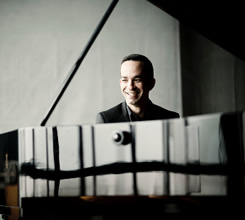A gala recital by the piano faculty of the Eastern Music Festival has been one of its more popular events since the Sheldon Morgenstern era. One of the earliest community outreach efforts that he made was to repeat the program in High Point. During André-Michel Schub’s tenure as music director, the venue was switched to McCrary Auditorium, at Elon University. Most years, the menu has involved two pianos and eight or more hands in a program of serious solos and showpieces, always culminating in a no-holds-barred performance of Horowitz’s arrangement of “Stars and Stripes Forever.” That always goes well with July 4 weekends.
Since 2006 is the 250th anniversary of Mozart’s birth, an imaginative and radical change of menu, heard June 29, was wholly justified. In the autumn of 1782, Mozart composed three piano concertos (K.413, 414, and 415) for Vienna. He was struggling to adapt and indeed to blaze a trail for the change from court or church patronage to the evolving public concert supported by money from the rising middle class. Leopold Mozart despaired of his son’s business practicality; fatherly concern was focused on the old patronage system. These three concertos find his son at his most business-like, composing works specifically to please a less informed audience and to secure sales of scores for home music-making. Exploiting an approach already used by Johann Samuel Schroeter, he wrote the orchestra parts so “the strings carry all of the essential material”; Steven Ledbetter’s excellent program notes explain that “the winds supply only color and reinforcement.” Home performances were intended for piano and a string quartet. Almost every reference quotes from Mozart’s letter to his father: “These concertos are a happy medium between what is too easy and too difficult; they are very brilliant, pleasing to the ear, and natural, without being vapid. There are passages here and there from which connoisseurs alone can derive satisfaction; but these passages are written in such a way that the less learned cannot fail to be pleased, though without knowing why.” This perfectly describes the concertos. Only in the last is the weight and timbre of the winds really missed.
Piano Concerto No. 11 in F, K.413, is the most light-weight of the three and more of a showpiece for the piano. It is unusual in that all three movements end quietly. The Larghetto middle movement, with its pizzicato accompaniment, sounds like an operatic serenade. This is the composer’s last finale in the form of a minuet. The themes and the string writing in Piano Concerto No. 12 in A, K.414, are much more attractive and interesting. Many commentators have drawn attention to the later importance to Beethoven of the technique of the harmonized theme stated by the piano in the slow movement. The finale finds the composer in his most bubbly mood. The Piano Concerto No. 13 in C, K.415, has the most complex scoring for both the piano and the strings, with fugal interplay in the first movement and bold modulations and connecting passages in it and the finale. The middle movement is conceived as an operatic aria. Most striking to his 18th century audiences were the two slower minor-key passages that interrupt the flow of the spirited rondo finale.
The EMF has always had a strong piano faculty, and this season is no exception. I would have to be an envious pianist with a performance degree to be able to split aesthetical hairs and to weigh the merits of each performer in relation to the other. I have praised all of them highly in past seasons and this Elon concert just reinforced those opinions. All displayed a refined feeling for the classical style, playing with a nuanced application of color and dynamics. Articulation was clear in the fastest passages. Gideon Rubin was the soloist for the Piano Concerto No. 11. High Point native and long-time faculty member James Giles was the soloist for Piano Concerto No. 12. Relative “newcomer” Yoshikazu Nagai was featured in the Piano Concerto No. 13.
The string “accompaniment” was made up of some remarkable talents, representing the Triangle and Charlotte. Half of the highly respected Ciompi Quartet was present in the form of first violinist Eric Pritchard and violist Jonathan Bagg. From the Charlotte Symphony were violinist Monica Boboc and principal cellist Alan Black. This repaid dividends in the more complex interactions between the pianist and the strings in the last concerto.











